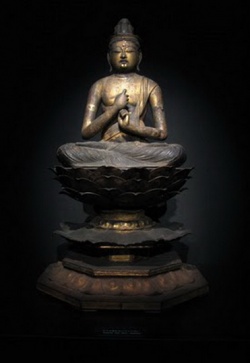Difference between revisions of "Afterword to the Lotus Sutra Translation"
(Created page with "thumb|250px| <poem> '''Afterword to the Lotus Sutra Translation''', The [法華翻経後記] (Chin Fa-hua-fan-ching-hou-chi; Jpn Hokke-hongyo-koki ) ...") |
|||
| (One intermediate revision by the same user not shown) | |||
| Line 1: | Line 1: | ||
[[File:Japan relig.jpg|thumb|250px|]] | [[File:Japan relig.jpg|thumb|250px|]] | ||
<poem> | <poem> | ||
| − | + | [[Afterword to the Lotus Sutra Translation]], The | |
| − | [法華翻経後記] (Chin Fa-hua-fan-ching-hou-chi; Jpn Hokke-hongyo-koki ) | + | [[法華翻経後記]] (Chin [[Fa-hua-fan-ching-hou-chi]]; Jpn [[Hokke-hongyo-koki]] ) |
| − | A short account of Kumarajiva's translation of the Lotus | + | A short account of [[Kumarajiva's]] translation of the [[Lotus Sutr]]a into {{Wiki|Chinese}} and of his work the [[Lotus Sutra of the Wonderful Law]]. It was written by the {{Wiki|Chinese}} priest [[Seng-chao]] (384-414), one of [[Kumarajiva's]] major [[disciples]]. This document describes why the [[Lotus Sutra of the Wonderful Law]], or the version translated by [[Kumarajiva]], consists of twenty-eight chapters including the "[[Devadatta]]" chapter, while the [[Lotus Sutra]] of the Correct Law, [[Dharmaraksha's]] version translated prior to [[Kumarajiva's]], consists of twenty-seven chapters. The Afterword to the [[Lotus Sutra]] Translation is included within The [[Lotus Sutra]] and Its [[Traditions]], an eighth-century work by [[Seng-hsiang]]. |
</poem> | </poem> | ||
{{R}} | {{R}} | ||
| Line 10: | Line 10: | ||
[[Category:Buddhist Terms]] | [[Category:Buddhist Terms]] | ||
[[Category:Lotus Sutra]] | [[Category:Lotus Sutra]] | ||
| − | [[Category: | + | [[Category:Kumārajīva]] |
Latest revision as of 17:14, 4 October 2013
Afterword to the Lotus Sutra Translation, The
法華翻経後記 (Chin Fa-hua-fan-ching-hou-chi; Jpn Hokke-hongyo-koki )
A short account of Kumarajiva's translation of the Lotus Sutra into Chinese and of his work the Lotus Sutra of the Wonderful Law. It was written by the Chinese priest Seng-chao (384-414), one of Kumarajiva's major disciples. This document describes why the Lotus Sutra of the Wonderful Law, or the version translated by Kumarajiva, consists of twenty-eight chapters including the "Devadatta" chapter, while the Lotus Sutra of the Correct Law, Dharmaraksha's version translated prior to Kumarajiva's, consists of twenty-seven chapters. The Afterword to the Lotus Sutra Translation is included within The Lotus Sutra and Its Traditions, an eighth-century work by Seng-hsiang.
